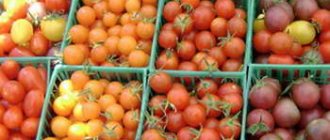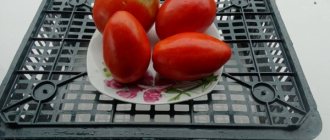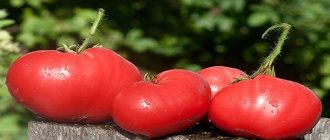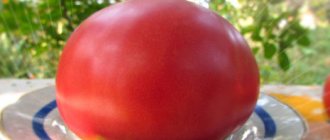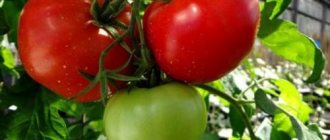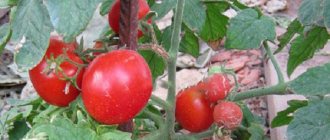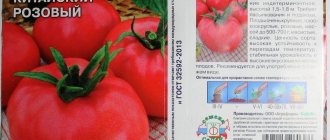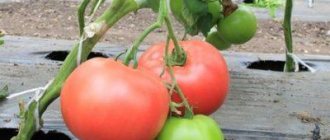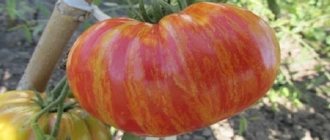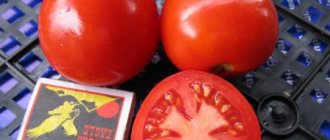Tomato Talalikhin 186 has won the love of many Siberians due to the fact that even in such cold latitudes it can grow and bear fruit without a greenhouse. There are some shortcomings, but they are more than compensated for by the considerable advantages of the variety.
| Height | Landing location | Ripening time | Fruit color | Fruit size | Origin | Fruit shape |
| short | Greenhouse, Open ground | Early ripening | Reds | Average | Variety | Flat-round |
Tomato Crystal
Variety originally from France
- Fact:
Over the entire summer season, you can harvest up to 35 kg of tomatoes per 1 m2. With drip irrigation and growing in a greenhouse, this figure can be even higher. - Fact 2:
Sweet and slightly sour tomatoes are suitable for home preparation and fresh consumption. For juices, pastes and purees. - Fact 3:
The average weight of the fruit is 140 g. Under good conditions it reaches 160 g. - Fact 4:
Seedlings need a lot of light and moderate watering through a strainer.
This is also interesting!
“Crystal F1” is a variety originally from France. It is popular due to the classic, beautiful shape and color of tomatoes, high yield and resistance to cool weather.
Description
“Crystal F1” is an indeterminate plant with unlimited trunk growth. For greater productivity, it is recommended to form the trunk into 2 stems and tie it to a vertical support.
The variety gives a good harvest. 70 days after the seedlings emerge, the first fruits weighing 120–140 g begin to appear. Over the entire summer season, you can harvest up to 35 kg of tomatoes per 1 m2. With drip irrigation and growing in a greenhouse, this figure can be even higher.
"Crystal" is universal in use. Sweet and slightly sour tomatoes are suitable for home preparation and fresh consumption. For juices, pastes and purees. They keep for a long time. They tolerate transportation well thanks to thick, up to 8 mm, walls.
Fruit
These tomatoes are very beautiful - smooth, without ribbing, round. Rich red color both inside and outside. When ripe, a green spot does not appear on the stalk. The pulp is juicy and elastic, without white veins and fibers. High in sugars. Each tomato has three small seed chambers.
The average weight of the fruit is 140 g. Under good conditions it reaches 160 g. Diameter is 30–35 mm. The tomatoes ripen together, in clusters. Each produces 8–10 tomatoes. The variety is not susceptible to cracking in garden beds and during transportation.
Advantages
excellent yield even in regions with cool summers;
immunity to many diseases - fusarium, tobacco mosaic, verticillium;
growing in greenhouses and garden beds;
possibility of harvesting with brushes;
excellent product characteristics.
Some difficulties may be caused by the need for pinching, shaping and tying up bushes.
Growing
"Crystal F1" is usually grown by seedlings. The timing of planting seeds depends on the region and climate type. In areas where frosts are possible in mid-May, seedlings begin to be grown around mid-April.
This variety requires light soil with a low or neutral pH. The seeds are planted at a depth of 1–1.5 cm. Cover and wait for the sprouts to appear. As soon as this happens, remove the film and move the future tomatoes into a cool place. The optimal temperature is –15–18˚С. After a week, it is increased by 5–7 degrees.
Barnaul canned tomato variety
The period of plant growth and development is 90-95 days. The bush is semi-standard, low-growing, 30-40 cm tall, with 5-6 fruiting shoots, does not require pinching, the leaf is entire, slightly dissected, small. The fruits are elongated oval, ovoid, smooth, 1-2 chambered, with a dense, almost non-cracking skin, weighing 30-40 g. Sugar content 1.86%, vitamin C - 20.3, carotene 4.4 mg/100 g .
The yield is 1.0-1.5 kg. from one bush.
On the vine it ripens up to 84-95 percent. The Barnaul canning variety is excellent for canning and pickling and is highly cold-resistant. Fruit clusters can form at low temperatures (10-12°C), while in most other tomato varieties the growth and development processes slow down or stop altogether.
Varietal characteristics
Having studied the characteristics of the Ozaltin tomato variety, it can be noted that the advantage of growing this variety of crop will be an excellent level of productivity. The fruits of the tomato plant have an amazing taste and excellent keeping quality. The growing season is relatively short. The first ripe tomatoes can be harvested on the 130th day. Sometimes it may take an additional 10 days for full ripening. Much depends on weather conditions and the amount of fertilizing applied by the farmer.
At the moment of biological maturity, you can see how the fruits turn a deep red color, which looks attractive due to the “glossy” surface of the skin. The pulp is dense, the tomato is meaty, which means it can be used to make surprisingly tasty sauces and ketchups.
The variety grows as a compact bush that is not spreading. However, it is a tall variety. Outwardly, it looks neater compared to its tall “relatives”. The bushes develop rich green foliage. Under ideal growth conditions it grows up to two meters.
With large plants, the gardener will have to work hard to form a garter so that the bush does not become deformed and the Ozaltina branches do not break off.
Due to the density of the fruits of the Ozaltin variety, based on reviews, we can confidently say that these tomatoes are ideal for canning.
Tomato grows unhindered in various regions of the country. But the chances of excellent fruiting increase if planted in a greenhouse shelter. Farmers who work on the land with agricultural plants in the south have good chances to reap the maximum harvest. It is in these regions that there is little risk that the tomato will be destroyed by sudden temperature changes.
The weight of the Ozaltin tomato fruit, according to the description, can be 60 g, or can reach 130 g.
Fact! You can grow large fruits from strong and healthy seedlings. Such seedlings can be obtained if you grow them yourself from your own seed.
Variety zoning
“Mongolian dwarf” is a tomato that has become widespread in Transbaikalia and Siberia. Although it is not listed in the State Register of Breeding Achievements of the Russian Federation, this does not prevent numerous fans from growing the variety and offering its seeds for sale.
The Mongolian dwarf tomato variety is just suitable for growing in risky farming zones. The description of the conditions of the “garden” period for most of Russia can be described as a short summer with sharp fluctuations in night and day temperatures. Heavy dew at the end of summer provokes the spread of late blight.
The new ultra-early ripening variety “Mongolian dwarf” allows you to get the main harvest before mid-August, avoiding disease.
The best areas for cultivation are southeast Russia and Siberia. Arid areas with long, mostly dry autumns are suitable.
In such areas, late blight rarely appears, which is important for a variety whose fruits mainly ripen on the ground.
Humid areas of the Non-Black Earth Region are not suitable for growing Mongolian dwarf tomato. In the southern regions, it is possible to sow seeds directly into the soil, without seedlings. On heavy soils it will not be possible to grow a decent crop.
Characteristics of tomato Swat f1 and description of growing variety
Tomato Swat f1, the description of which indicates the universal purpose of the fruit, is one of the best tomatoes. During the growing season, a powerful bush is formed, on which large fruits of an even round shape ripen. The variety is resistant to stressful cultivation conditions.
Benefits of tomato
Swat tomatoes are first generation hybrids and are suitable for growing in any conditions. The seeds belong to class 1, which indicates a high germination rate. The description of the variety indicates an early ripening period.
Bushes of indeterminate type. In open ground, the height of the plant reaches 70 cm; when cultivated in a greenhouse, a bush 120 cm high is formed.
The characteristics and description of the variety are related to the parameters of the fruit. At the stage of technical ripeness, tomatoes acquire a pink color. Tomatoes have a smooth surface, juicy pulp, and large size. The weight of the fruit is 500 g. Sometimes the weight of tomatoes can reach 800 g.
Swat f1 tomatoes have a balanced taste. The fruits are intended for canning and fresh consumption.
Growing seedlings
When planting a crop, it is important to follow hygiene rules, as there is a possibility of infection reaching the seeds through the growing container. It is preferable to carry out all work when planting seeds with gloves, wash your hands periodically
For this purpose, you can use expanded clay or crushed charcoal. For planting, take a specially prepared soil mixture. You can simplify the process using a substrate, which is sold in stores.
The soil is lightly compacted, watered with warm water, holes are made 1 cm deep. The seeds are laid out at a distance of 3 cm from each other. The sowing is covered with a layer of dry soil, and the container is placed in a warm place.
To ensure the smooth emergence of seedlings, it is important to maintain the optimal air temperature at +28...+30 °C. Compliance with the temperature regime is required to accelerate the emergence of sprouts
Otherwise, the seeds will rot or the germination period will increase.
After the first shoots appear, lower the air temperature to +15...+18 °C during the day and +10...+12 °C at night. After 7 days, the air temperature is increased to +20...+25 °C during the day and +12...+15 °C at night.
Rules for cultivating the variety
Caring for tomato plants requires compliance with the rules of agricultural technology. Tomatoes need fertilizing with mineral fertilizers. Complex preparations are applied before planting seedlings in the ground.
At the cotyledon stage, plants are planted in separate pots. At the same time, the central root is shortened, resulting in a more developed root system. When picking, you need to monitor the condition of the root and prevent it from deforming.
After the appearance of 1 flower cluster, the formed seedlings are transferred to a permanent place when the air warms up to +13…+14 °C.
Plants are planted taking into account crop rotation. The best precursors for tomatoes are cucumbers, grains and legumes.
After planting in the ground, the seedlings are tied to a support after 10 days. In order to increase the yield, 1 stem is formed from the bush, and excess shoots are removed. As the tomatoes ripen, it is recommended to tear off the lower and partially middle leaves.
To increase productivity, it is recommended to fertilize with an aqueous solution of yeast. For preventive purposes against fungal diseases, the bushes are treated 2-3 times during the season with a mixture containing copper. It is recommended to use a Bordeaux mixture consisting of slaked lime and copper sulfate.
Tomato variety Khachmas
The bush is determinate, the period of growth and development is 120-131 days. The brush is simple, compact, with 4-6 fruits. The first brush is above the 9-1st sheet, the next after 2 sheets. Fruit weight is 120-130 g. The fruits are round, smooth, without a green spot at the stalk, look good and are stored. This variety is excellent for growing in film greenhouses, showing yields of up to 10-11 kg/m2 . The bush is formed in one and two-stem cultures. The Khachmaz variety can be safely grown in winter greenhouses (which is very important for cold regions). It can also be grown in open ground. but then pinching and gartering are necessary.
The best varieties of tomatoes Siberian Garden
All tomatoes can be divided into several categories: early-ripening, tall, medium-sized, suitable for pickling. There are a lot of these groups. Before purchasing seeds, you need to study the description of each variety and select Siberian Garden tomato seeds for your garden.
Pink large f1
A fairly new hybrid that combines several main qualities: early ripeness, large fruit and high yield.
This variety also has a low bush type, which is important for gardeners
Tomato Pink large f1 Siberian Garden is intended for growing in greenhouses or film shelters. The time from seed germination to final fruit ripening varies from 90 to 97 days. The weight of large fruits reaches 300 g. The tomatoes are fleshy, have a round shape with irregularities.
Regimental commander
Mid-season and large-fruited variety. Designed for planting in film shelters or in open ground.
Tomato Regiment Commander Siberian Garden is quite popular among farmers.
Casanova
Tomato Casanova Siberian Garden belongs to the category of mid-season, high-yielding and indeterminate. Designed for greenhouse cultivation. The height of the bush reaches 2 meters, so it requires support and a garter. The formation of a bush must be done in 1 or 2 stems. The fruits are juicy and oblong in shape.
Ultra early ripening
From the name it is clear that this variety belongs to the category of early ripening. Thus, fruit ripening occurs within 67-70 days after sowing. The Ultra Early Siberian Garden tomato is quite resistant to temperature changes, so it can be planted both in a greenhouse and in open ground.
The height of the bush varies from 50 to 60 cm. The fruits have a bright red color and a perfectly round shape. They are formed with tassels, and the weight of each tomato does not exceed 100 g.
Stellate sturgeon
Mid-season, has very large fruits. The height of the bush reaches 1.5 meters. With proper care, the fruits can grow up to a weight of 1.5 kg. The pulp is fleshy, sugary, and has an excellent taste. Color - bright red.
Wonder of the earth
Mid-season tomato Siberian Garden Miracle of the earth with large crimson-colored fruits. The plant reaches a height of 2 meters. The taste of the fruit is delicate, the yield is high.
bbw
Mid-ripening variety (112-116 days), the fruits are quite large. The plant reaches a height of 80 cm. It is recommended to plant in greenhouses or closed ground. Tomatoes are great for fresh consumption and for making salads. The Siberian garden tomato Tolstushka, according to reviews, is considered one of the most favorite tomatoes among summer residents.
Mystery of nature
Large-fruited, mid-season, indeterminate variety. Tomato Mystery of Nature Siberian Garden is recommended for growing in greenhouse conditions. The plant is quite powerful, up to 2 meters high. The foliage is dark green and medium in size.
The weight of the fruit varies from 350 to 700 g. The color range is red-pink, with shades of yellow in the cut. It is better to form a bush in 1 or 2 stems.
Pink honey
Tomato Rose Honey Siberian Garden belongs to mid-season, determinate and semi-determinant other varieties. Requires tying and pinching, while the height of the bush can reach 1.4 meters.
The fruits are round in shape, quite large - the weight with proper care can reach 1.3-1.5 kg. The color is bright pink, the fruits are fleshy and have a sweet taste.
Digitomandra
Tomato Cyfomandra Siberian Garden is called the “tomato tree”, and it fully lives up to this name. The plant is indeterminate, has a strong trunk and moderate branching. The fruits are light red in color, formed in clusters of 5-6 pieces. They are ideal for canning, as well as for fresh consumption. The average fruit weight is 200 g.
Expert opinion Filatov Ivan Yurievich, private farmer for more than 30 years
It is recommended to purchase Siberian Garden tomato seeds directly from the manufacturer or through trusted intermediaries. Beware of fakes!
Low-growing, early-ripening tomatoes grown in Siberia
Due to the climate of the region, summer residents try to grow early-ripening varieties of tomatoes in open ground. The following tomatoes are popular:
- White filling 241 (salad early mid-season).
- Buyan yellow (early salad).
- Fighter (universal early drought-resistant).
- Dubrava (variety of early ripeness).
- Lucky (harvest early lettuce).
- Red North (early ripening for canning).
- Rocket (disease-resistant early for canned whole fruits).
- Duckling (early tomato is intended for canning and salads).
- Hospitable (also early ripening with large fruits).
This is a small part of the tomatoes that were grown by breeders and hobbyists in the West Siberian region. The varieties take root and produce an excellent harvest in greenhouse conditions and open ground. Thanks to their taste, tomatoes have positive reviews from grateful summer residents. Among the huge selection, there is one excellent variety Talalikhin 186, which we will consider.
Tomato 'Talalihin 186'
Main genus: Tomato
| Size |
| Productivity |
| Ripening period |
| Soil type |
| Growing method |
| Purpose of fruits |
| Disease resistance |
| Soil ph requirements |
| Life form |
| Shape of fruits/stems/roots and tubers/heads |
| Size of fruits/stems/roots and tubers/heads |
| Cultivation region by origin |
| Vitamin content |
| Color of fruits/roots and tubers |
| Leaf/stem/head color |
| Fruit/root and tuber pulp color |
| Peel thickness |
| Frost resistance |
| Drought resistance |
| Decorative value |
| Taste of fruits |
| Shelter for the winter |
| Pest resistance |
| Habit |
| Keeping quality |
| Parthenocarpic |
| Branching pattern |
| Density and character of the pulp |
Expand all properties
Description of the plant:
Tomato 'Talalihin 186' is a variety obtained by the Belarusian Research Institute of Potato and Horticulture. Approved for use in the Central, Volga-Vyatka, North Caucasus, Middle Volga, Lower Volga, Ural, West Siberian and East Siberian regions in 1954.
Recommended for growing in open ground.
Dimensions and growth form:
The 'Talalikhin 186' variety is represented by determinate, semi-spreading plants with a main stem height of 34–67 cm. The foliage is moderate. The leaf is ordinary, medium size, green, slightly corrugated.
The inflorescence is simple, short (6-9 cm), compact. The first inflorescence is formed above the 7-8th leaf, the subsequent ones - after 1-2 leaves. On the main stem, 2–4 clusters with 2–3 fruits are formed.
Fruit:
Size, shape and color:
The fruit is flat-round in shape, medium in size, weighing 76–100 g. The surface is smooth or slightly ribbed. The color of the unripe fruit is green, with a dark spot at the stalk; the color of the ripe fruit is red. The number of nests is 6–8, the location is correct.
The taste of the fruit is satisfactory.
Ripening time and yield:
Tomato 'Talalikhin 186' is an early ripening variety. The period from full germination to fruit ripening is 103–112 days. Productivity 2.4–6.3 kg/m2.
Directions for use:
Recommended for fresh consumption and processing into tomato products.
Tomato variety Talalikhin
The period of plant growth and development is 100-106 days. The bush is determinate, low-growing, spreading, no longer than 70 cm, diameter is 35-45 cm. The leaves are dark green, slightly corrugated. The brush is simple, compact; The first brush is placed above the 7-8th sheet. The fruits are round and flat-round, smooth, weighing 100-120 g, pleasant to the taste.
The yield is 2.3-3.0 kg per bush.
Aging: 35-60 percent. When grown in greenhouse conditions, the yield of ripened fruits is 10.5 kg/m2. This tomato variety is susceptible to diseases, most often late blight.
Characteristics of compact and early ripening tomato variety Betalux, cultivation and care
Relatively new to the Russian seed market, Betalux tomato is finding its fans very quickly. The variety is a Polish selection, but grows well in the conditions of central Russia in open ground and greenhouses. The housewife who planted tomatoes as an experiment will not give up the desire to leave the seeds for the next season.
General characteristics of the plant
The variety is ultra-early, super-determinate. This type of plant usually bears fruit quickly and completely completes the growing season in 2-3 weeks. Reviews from gardeners who worked with Betalux in open ground indicate the ability of the variety to produce 2 harvests and bear fruit until autumn.
The first ripened tomatoes (several berries from each bush) are harvested 1 month after planting the seedlings. In greenhouse conditions, this can be done as early as mid-June. The period of 90-95 days declared by the manufacturer from sowing to ripening is fully maintained; Betalux tomatoes are one of the first to produce a harvest.
The main yield of the harvest begins 10-15 days after collecting the first fruits. The most abundant harvest will be about 4 kg per 1 m² (5-6 bushes).
The last saturated ovaries can be removed in mid-August, after which the plant’s growing season ends. The total yield per unit area is about 6-7 kg.
The bushes are compact, in open ground they do not exceed 30 cm in height, but in a greenhouse they can be larger - up to 50 cm. The plant has a rigid stem, it can be grown without pinching and without tying it to a support.
In greenhouse conditions, compact bushes are convenient to plant under tall tomatoes. But the description of the variety given by gardeners notes that in such conditions many small fruits are formed. The tomato bears fruit continuously for 1-1.5 months.
Consumer properties of Betalux tomatoes
The ovaries are formed on simple or double racemes, 4-5 pieces on each branch. Fruits of equal size ripen at the same time. The weight of 1 tomato rarely exceeds 100 g.
The shape is round, without pronounced ribbing. The color of a ripe tomato is bright red; when technically ripe, the fruits are pale green, with a spot at the stalk.
In open ground, greenish areas may remain on the hangers.
The skin is strong, but not thick. Tomatoes are not subject to cracking when filling and ripening, and tolerate transportation well even when ripe. The shelf life of the fruit reaches 5-7 days, and blanc tomatoes can be stored and gradually ripen for 2 weeks.
The taste of a ripe tomato is sweet and sour, classic, with a pronounced characteristic aroma.
These tomatoes have a universal purpose. The early ripeness of the Betalux variety makes it indispensable for fresh consumption. From bright, juicy and tasty tomatoes you can prepare a variety of salads, snacks, and gazpacho. The well-colored pulp is suitable for hot sauces, vegetable caviar, borscht dressings and soups. Small tomatoes are convenient to bake and stuff.
Betalux is an ideal variety for winter preparations. Small calibrated tomatoes look great in canned form and successfully complement assorted vegetables.
The thick skin does not burst, and the pulp retains its structure and does not spread. Ripe fruits are processed into juice or sauces.
The pulp from fleshy tomatoes becomes quite thick; it can be boiled to the desired state in a short time, which ensures the preservation of almost all vitamins.
For the substrate, mix equal parts of sand, fertile soil and humus. For 10 kg of mixture add 2 tbsp. l. ground chalk or eggshells.
Disinfect the soil directly in the container where the seeds will be sown. A hot solution of potassium permanganate is used for processing.
Seeds can be sown immediately after the soil has cooled to room temperature.
The Betalux tomato variety is not a first-generation hybrid; seedlings are also grown from seeds from their own bushes, which have shown varietal qualities better than others.
The seeds are soaked for 30-40 minutes and then dried to a loose state.
Spread the grains over the surface of the wet soil and cover with dry soil or sand on top. The thickness of the layer should not exceed 0.5 cm. To preserve moisture, cover the box with film with holes and place it in a warm place (+25°C). After the shoots appear, remove the film.
Seedlings dive in the phase of 2-3 true leaves at a distance of 10 cm from each other. After the end of the return frosts, the tomatoes can be planted in the garden. Planting scheme for a compact variety 40x40 cm or 30x60 cm. Further care consists of timely watering of the plants and hilling the base of the stem approximately 1 week after planting.
New tomato variety from Altai
The bush is determinate, 38-65 cm high. The first brush is laid above the 6-8th leaf, the subsequent ones - through the leaf. The brush is simple, with 5-6 fruits. The fruits are round and round-oval, smooth or slightly ribbed, red; unripe ones are light green, without a green spot at the stalk. Fruit weight 80-100 g.
The yield is 2.0-2.3 kg per bush.
Of these, 56-70 percent are mature. The “New Altai” variety is well suited for growing in film greenhouses, showing a yield of up to 8-9 kg/m2. Also, its positive feature is its resistance to disease. The fruits are stored for a long time and well.
Bush care
Next, carry out the following care activities:
- Water every 7-10 days. Using a drip irrigation system will significantly increase productivity;
- Be sure to mulch the soil using straw or mowed grass;
- Fertilizers are applied in a timely manner. The first time is fed at the stage of active growth of young seedlings, then 10 days after the second ovary begins to flower, the third time after the first harvest;
- Regularly ventilate the greenhouse structure, especially after watering;
This will help avoid high humidity in the room, which can cause fungal diseases.
- Loosen the soil and weed the plantings to remove weeds;
- Tall bushes must be tied to a vertical trellis as they grow, and pinching is also recommended;
- The hybrid shows high yield when growing a bush with two stems;
- As soon as the fruits appear on 3-5 ovaries, they tear off all the lower leaves on the bush, freeing the stem to the base of the second cluster. The procedure helps improve air flow to the plant, which has a positive effect on further growth, increases resistance to fungal diseases, and also shortens the period of fruit ripening.
Tomato Talalikhin 186 - description and characteristics of the variety
The tomato was obtained by agricultural technology specialists at the Belarusian Research Institute of Potato Growing back in 1954. During this time, it proved itself only on the positive side and acquired a significant number of admirers among gardeners. Recommended for growing in open ground and greenhouse conditions. Yes, the first method is more common.
Characteristics
An early-ripening, determinate variety with a sweetish, slightly sour taste. Grows to a height of 40-70 centimeters, semi-spreading bushes. A simple glass. The first appears above the seventh sheet. Subsequent ones - through failure. 3-4 clusters with 2-3 fruits grow on the main stem.
Tomatoes have a flat-round shape. The size is not very good. Colour: Dark green before ripening, then orange or brilliant red. Inside a tomato there are from 7 to 13 seed chambers. The leaves are medium sized and green. The value of the fruit is about 80-110 grams. The skin is smooth with barely noticeable ribs. Has 6-8 according to the rules of located nests.
From the moment the seedlings are planted in the ground until the harvest, 100-110 days pass. It bears fruit in large quantities within two months. Productivity ranges from 2.5 to 6.5 kilograms per square meter.
Used fresh. Used for making juices, tomato paste and ketchup.
Features of cultivation
Winter. Ant. Harvesting seeds in open ground is not practiced; the crop will most likely die. Seed material is planted in a special container from mid-March to mid-April, providing the required temperature conditions and good lighting. When the first leaves appear, a pick is made. It is better to drown the sprouts with warm water.
After 55-60 days (approximately mid-May), the seedlings are transferred to open ground to a depth of less than 4 centimeters. At the same time, they are protected from temperature changes by covering material. Due to this, it can be removed two weeks after planting the bushes. It would be a good idea to place manure or chicken manure among the holes.
To get a decent harvest, there is no need to invest large quantities of peat and expensive fertilizers into the soil. Systematic loosening, layering and fertilizing of the soil will be sufficient.
Watering is best done after sunset or early in the morning. If you do this during the day, then only in cloudy weather. Feeding the soil is carried out twice during the growth of the plant. The main time this is done is when the ovary appears (nitrogen and potassium fields are used)). The second time - when tomatoes appear (phosphorus and potassium mixtures are used).
In (types of root aeration, it is necessary to loosen the soil in a timely manner. This will help in the fight against pests that attack the root system of the tomato. It is recommended to weed the beds weekly. Otherwise, crop losses may amount to 30 percent.
To combat diseases, plant leaves are treated with special substances. Chemicals can be used to kill pests. The main thing in this matter is unimportant (= unimportant) to overdo it. Adding ash flour to the soil is effective in pest control.
You can ensure good fruiting by following simple care measures:
- Prepare the land for planting first-class.
- Plant the sprouts at a distance of 20-30 centimeters.
- Perform gartering and pinching (only once, forming a plant with three stems).
- During the growth round, make sure that the bush does not come into contact with the ground. Otherwise the risk is high. Ant. impossibility of infection with late blight.
- Feed and water in a timely manner.
- Systematically carry out measures to protect against diseases and pests.
Having completed all these operations, the hacienda has the right to hope for an excellent result.
Advantages and disadvantages
The advantages of the Talalikhin 186 tomato can probably be considered:
- Pleasant taste.
- Good fruiting.
- Survival to low temperatures.
- Harmonious ripening of fruits.
- Marketable condition.
The disadvantages include:
- Poor protection against fungal diseases.
- Poor transportability (fruits become wrinkled and rot during transportation).
Ground tomato variety Gribovsky
Period of plant growth and development (from germination to fruit ripening): 100-110 days. The bush is determinate, medium leafy, semi-erect. When grown without pinching, 4-5 shoots are formed, 45-55 cm high. The leaf is slightly corrugated, almost smooth. The cluster is simple, compact, with a frequent arrangement of smooth, intensely red fruits of a round or flat-round shape. The fruits are 4-7 chambered, weighing 50-70 g.
The yield is 2.5-3.0 kg. from the bush.
The proportion of ripened fruits is 70-80 percent. The first cluster is the most prolific, which gives the variety high resistance to bad weather conditions, for example, low temperatures. In cold and rainy years, with a short period of growth and development, the “ground Gribovsky” variety shows good yield and high rates of fruit ripening.
Tomato Gold of the East - description and characteristics of the variety
Characteristics of the variety
The “Gold of the East” tomato received its unusual designation for its color, similar to the color of the noble metal. The famous variety is included in the “Oriental Delicacy” collection because it has an exotic taste. The seedlings have adapted well to the difficult climatic conditions of our country, and are successfully cultivated in the middle zone. In addition, it feels great both in greenhouse conditions and in open ground. The variety belongs to mid-season tomatoes. Its growing season is about 115 days, which allows it to form a decent harvest in regions where there is a short period of above-zero temperatures.
If we don’t talk about the main characteristics of this variety, then it’s worth paying attention to the following qualities:
- The Zoloto Vostok tomato can be grown in open soils without shelter in places with a warm climate.
- A mature plant reaches two meters in height and forms the so-called indeterminate bush type. Therefore, agrotechnical measures include the mandatory removal of side shoots and timely pinching of growth points. Moreover, such procedures should be carried out regularly.
- By the time of ripening, tomato bushes form clusters, on top of which there are up to 6 massive honey-colored fruits. The authority of other specimens reaches 0.4 kg.
- The hybrid Gold of the East is famous for its amazing sweetish taste and juicy pulp.
- This variety can withstand relatively long shelf life, even if it is mainly used for preparing salads and canning.
Useful notice!
It is recommended to remove the tomatoes from the “gold” series together with the stalk, and after some time they ripen at room temperature for about a week. After this time, the fruits have time to acquire the characteristic taste of this variety.
Advantages of a hybrid
When creating the variety, breeders tried to combine the best qualities of famous tomatoes in their brainchild. Therefore, triticale “Gold of the East” has a number of advantages:
- It can be safely cultivated in various conditions: greenhouses, open ground.
- The short growing season allows the fruits to ripen completely.
- Consistently high yields make the current variety the most promising for growing in summer cottages.
- The range of nutritional components, including organic acids and a whole complex of vitamins, allows you to use tomatoes of this variety for dietary nutrition.
Of course, the main value of the Zoloto Vostok tomato is its exotic taste. This quality is especially appreciated by gardeners and gourmets. Tea from this member of the nightshade family can be used to prepare a variety of delicacies and snacks using minimal heat treatment.
Agricultural technology instructions
Before sowing seeds, which is usually done in the middle of Marfa, care must be taken to prepare containers appropriate for these purposes. Experts recommend using special containers with a drainage hole, which will prevent seedlings from becoming sick. Containers for seedlings are filled with a mixture of peat and sand, and before sowing, the prepared soil should be treated with a solution of potassium permanganate. Superelite is laid to a depth of 1 cm, and the planting site is sprayed with warm water. You can use a regular sprayer for this.
To provide favorable conditions for the sprouts, sowing should be done at a distance of 4 cm. After sowing, the container should be covered with film and placed in a lighted place where there is good circulation of air masses. Until the first shoots appear, it is necessary to maintain the temperature at +23 C. When the sprouts “hatch”, it is not forbidden to remove the film.
Care instructions
- Regular watering.
- There, the formation of 2 true leaves requires diving of the seedlings.
- In the second half of May, the strong sprouts are planted in a greenhouse. They should be planted in open soils after the frosts have stopped.
- Planting frequency – 4 plants per square meter of planting area.
- Tomatoes need to be tied to a reliable support.
- From time to time the bushes will form; you need to pinch them. Side shoots should be removed regularly.
- The feeding and watering periods for this variety are unmistakably the same as for other tomatoes.
Important stay here!
The hybrid Zoloto Vostok can be grown in one place for several years in a row if the soil is enriched with organic fertilizers.
Metal of the East is one of the few crops that have gained a special position among summer residents and farmers. Unpretentious to care for, tomatoes produce amazingly large yields. Therefore, the reviews from gardening enthusiasts are the most positive.
